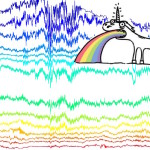
It hasn’t been too long since Brendan Roark first reported that deep-sea corals off Hawaii are clocking in as the world’s oldest animal. At four thousand years old, the Leiopathes sp. black corals beat the quahog clams, which live to be four hundred, and they beat the tortoise Jonathon, who’s 176. Of course, these deep-sea gold and black corals are colonial creatures, a little bit like the giant honey mushroom in Oregon that 35 miles across and 2400 years old. That means the individual polyps can die back, but the stalk remains for the polyps to recolonize. Here lies a bit of a conflict, which was published March 23 in the online edition of PNAS.
The polyps may have been feeding on re-suspended sediment, which could have a carbon signature older than the colony, not on photosynthesized carbon from surface waters. However, the carbon 14 in the polyps matches the overlying water column, indeed its been reported that the deep-sea corals are feeding on freshly minted organic material as young as five days old. That’s rapid transport to the deep-sea. Read more about the details from Roark’s colleague Dr. Tom Guilderson at Lawrence-Livermore National Laboratory. The investigation was teamwork from a broad group of scientists from Stanford, LLNL, UC Santa Cruz, and Hawaii Undersea Research Laboratories.
To credit the skeptics, once you take the carbon 14 out of the picture, not everything makes sense. Dr. Richard Grigg at Univ of Hawaii has been studying in-situ growth rates of black corals and gold corals since the mid-70’s. He’s perhaps the only person in Hawaii to have actually tagged a coral 400 m deep and returned to measure its radial growth. Grigg estimated these corals at 70 years. He told me once, “There’s one thing you can’t deny, and that’s reality.” Nature News gives credit to the argument that the animals ingest old and new carbon.
Part of the confusion lies in the fact that growth rings in the marine environment are not necessarily annual growth rings. Bamboo corals are relatively “weedy” deep-coral species, from 50 – 150 years old. These have subannual, or lunar, growth rings linked to plankton cycles (Roark et al 2005) or tidal fluctuations on seamounts. Gold corals may lay down their growth rings once a decade. The problem is there has been no longitudinal study measuring in-situ growth rates, current flows, and suspended sediments, so perhaps we’ll never know for sure.
Here’s a few things to consider. First, benthic cnidarians are one of the most basal groups in the tree of life, among the oldest metazoans, in the fossil record back to the Proterozoic. Let’s just say they’re highly adapted to their environment. Second, if you think about clonal marine organisms, you’ll eventually need to revise your definition of what makes a living thing. Anemones reproduce clones by pinching off little buds of flesh. They have been called “immortal” in the sense that their DNA lingers on even as the cloned individuals expire. How do you define old in this sense? Finally, there is evidence that some deep octocorals have expired, and their axis recolonized. The evidence is in the relaxed growth of a 300 year old bamboo coral (Noe and Dullo 2006). Did the colony ever die if it lived to grow again?
Either way, the carbon says these corals are old as the hills, my friends. Think about that next time you order the orange roughy. They trawl for that stuff, dragging up corals by the dozens.
UPDATE, April 6 – Gerardia captured alive on video!
Citation:
Roark, E., Guilderson, T., Dunbar, R., Fallon, S., & Mucciarone, D. (2009). Extreme longevity in proteinaceous deep-sea corals Proceedings of the National Academy of Sciences DOI: 10.1073/pnas.0810875106
Noé, S., & Dullo, W. (2006). Skeletal morphogenesis and growth mode of modern and fossil deep-water isidid gorgonians (Octocorallia) in the West Pacific (New Zealand and Sea of Okhotsk) Coral Reefs, 25 (3), 303-320 DOI: 10.1007/s00338-006-0095-8
Roark, E., Guilderson, T.P., Flood-Page, S., Dunbar, R.B., Ingram, B.L., Fallon, S.J., & McCulloch, M. (2005). Radiocarbon-based ages and growth rates of bamboo corals from the Gulf of Alaska Geophysical Research Letters, 32 (4) DOI: 10.1029/2004GL021919






So..I have problems with this statement:
“Here’s a few things to consider. First, benthic cnidarians are one of the most basal groups in the tree of life, perhaps the oldest metazoans, in the fossil record back to the Proterozoic. Let’s just say they’re highly adapted to their environment.”
The longevity of these animals has NOTHING to do with their phylogenetic position or longevity of their LINEAGES. This is a really misleading statement trying to link two very disparate concepts together. Most Paleozoic organisms, phylogenetically have nothing to do with what’s around more recent geologic time.
Plus, I suspect the sponge people will have their differing opinions about what makes up the oldest metazoans.
Hey, great, Chris, you read to the end! I probably got off easy. I get your point, but I’m really not asking you to link their phylogenetic position to their longevity other than to say that, like the sponges, deep corals have been around a long time and will have developed remarkable survival strategies to adapt to the broad range of oceanic conditions over the last 400 million years. The oldest metazoans remark is definitely not intended to exclude sponges, rather to link through to Mike Risk’s excellent summary that does a much better job of linking phylogenetic position to longevity, at least in narrative. Your cautionary remark is well noted. Thanks for your insights.
I think this puts them in par with the oldest living plant. I think it’s some sort of coniferous thingy up in the Rockies at around 4 thousand years (at least if my memory serves me right).
So score another one for the inverts!
Is it perhaps better to distinguish between clonal, colonial species and sexual, non-colonial species?
it’s true, sequoias and bristlecone pines can live for 3000-4000 years in the Pacific Northwest USA. Link: http://www.rmtrr.org/oldlist.htm
Gold corals were orignally called “bristlecones pines of the sea” back in 1995 when the news first came out. The major contribution of Roark et al is the longevity of Leiopathes black corals.
It probably would be good to distinguish colonial and clonal animals, but then deep-corals would have to give it up to a quahog? I don’t think so!
I love this Fox News headline “Scientists Find Oldest Living Animal, Then Kill It” http://www.foxnews.com/story/0,2933,306076,00.html
Ok, I’m split on that one, I mean the Quahog is rather cool, and molluscan after all, but I admit it’s not anywhere as beautiful or exciting to see as a deep coral. Maybe a star by the name you know like the ones the modern sports people use to distinguish between absolute record and record without enhancements (yes I’m equating clonal colonial animals with performance enhancement, is that so wrong?)?
The Quahog headline is rich, especially since it didn’t taste that good either. ;) So what do you put in your Deep Sea bouillabaisse?
No argument on the Leiopathes work – although I have yet to read the argument/paper. But, the Gerardia stuff is full of potential pitfalls, as you state here. Somewhere someone should mention these guys are zoanthids, and that they strengthen their body with debris and detritus from the surrounding environment. Hmmm – wonder how old they truly are? Add in the clonal concept, and you have a mess waiting to happen for us researchers. Some microsat stuff looking at populations could provide some hints.
Any Leiopathes people out there with further thoughts/ideas?
Should also be mentioned that zoantharians often colonize exposed branches of deep-corals, where branches have died back or polyps been eaten by predators.
I just came across this from Circus of the Spineless. Very interesting article. I linked to it over at The Primate Diaries. I wrote an essay recently on an earlier controversy of the corals which you might be intersted in.
2700 years old? Wow. That must be boring :)
The world’s oldest animals are the dinosaurs ;) It is very interesting. However, I don’t think it is quite right to call coral the oldest animal. Although it is seen as a single organism, the polips are the real living things there. The skeleton is 4000 years old, not the polips. Theoretically we can also find a termite nest that is thousands of years old but that won’t make a termite old. If this coral thing went for the Guinness record book, it would be really difficult to judge – is this age valid or not…
Termites are not the best analogy because coral polyps are sessile, and obligated to life on the axis. Termites are mobile, and independent of the nest. Still, you make a good point, and this is quite an interesting question. I agree with Duncan that we should submit this to the Guinness book for a ruling. Guinness. Brilliant!
Excellent info, I’m going to post a link of this.